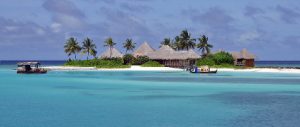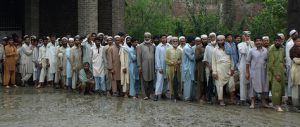The climate is changing and human beings will need to change with it. People will have to adapt to floods, droughts, disease, increasingly severe weather events and disrupted water and food supplies. But some of those facing these threats have limited capacity to respond. International finance to help vulnerable nations adapt to climate change is therefore hugely important.
But who accesses these funds and how they access them are already hotly contested issues. At the heart of this debate are differing views over the status of adaptation. Should it be considered aid or reparations for past wrongs? More prosaically, can adaptation actually work, or will it fall prey to the types of problems that have hindered development aid and international attempts to reduce greenhouse-gas emissions?
At global climate-change negotiations in Copenhagen last year, it was agreed that developed nations would provide US$30 billion (201 billion yuan) in new funding for developing nations between 2010 and 2012, and the money would be split between helping people adapt to climate change and financing projects to alleviate its effects. A further US$100 billion (666 billion yuan) would be found from public and private sources between 2012 and 2020, and the most vulnerable nations given priority access to funds for adaptation.
However, implementing these promises has proved difficult. For a start, developing nations have expressed concerns that these funds are not going to be “new and additional” as promised, and that money may be counted as both adaptation finance and development aid. In November, a high-level panel assembled by United Nations secretary-general Ban Ki Moon will issue recommendations on how to find new money. Norwegian prime minister Jens Stoltenberg, who co-chaired a panel advising the UN on the issue, said in October that it is “challenging but feasible, achievable to raise the $100 billion”, further noting that “carbon pricing” in the developed world would need to be part of the solution.
Another fault-line is emerging over definitions of vulnerability. The Copenhagen Accord states that “funding for adaptation will be prioritised for the most vulnerable developing countries, such as the least developed countries, small island developing states and Africa.” But exactly who qualifies remains a point of contention. Pakistan, for example, beset by terrible floods that may have been exacerbated by climate change, is requesting access to adaptation funds. Pakistan does not fit the definition but, facing huge shortfalls in aid to flood-hit regions, is seeking to contest and expand it.
Linda Siegele, a lawyer at the UK-based Foundation for International Environmental Law and Development (FIELD) noted that this is a “difficult and divisive issue right now among developing nations. There is a huge fear that there is a limited pie and that everyone wants a piece of it. I don’t think that’s a realistic picture. There has to be some priority setting.”
Negotiations over how the money would be disbursed also stalled at Copenhagen. Existing multilateral entities like the World Bank seemed well placed to channel funds. Some donor nations were also keen to provide funds directly on a bilateral basis. But many developing nations rejected these ideas, arguing that institutions like the World Bank had a bad track record in providing finance to developing nations, in part because these institutions were controlled and administered by developed nations. Bilateral funding would also lead to uneven outcomes, with some nations favoured while others missed out, they said.
The key point here is that adaptation finance is not aid. Existing processes were designed to provide grants and loans from developed nations. Sven Harmeling, an expert on climate change adaptation at German NGO Germanwatch, notes that “developing countries are entitled to receive adaptation funds because of the harm done by (developed country) greenhouse-gas emissions.” As such they have a moral case that they should have a say over how money is provided and spent. Funding for adaptation is not granted but owed.
An existing United Nations institution – the Adaptation Fund – might be part of the solution to this impasse. The fund uses an approach known as “direct access”, where a developing country can nominate a national institution to receive resources. This institution is then responsible for overseeing and reporting on how the funds are used. This gives recipient countries a larger say in how the funds are spent. More practically, Harmeling notes “an international fund alone cannot decide on hundreds or thousands of projects. It wouldn’t know the local situations, while national entities are better placed to evaluate projects.”
Developing nations can still access funds through accredited multilateral institutions, including the World Bank, if they choose. Ultimately it is likely that the innovative financial architecture provided by the adaptation fund will play a role, but it will almost certainly be alongside traditional multilateral institutions like the World Bank and bilateral finance.
The Adaptation Fund draws money from a 2% levy on the Clean Development Mechanism along with direct donations, ranging from a 45 million euro contribution (US$63 million) from Spain to a 100 euro (US$140) donation from European schoolchildren. In June, projects from Nicaragua, Pakistan, Senegal and the Solomon Islands received funding for adaptation projects to combat sea-level rise, deal with droughts and floods and reduce risks associated with glacial-lake outbursts.
The project in the Solomon Islands illustrates just how much planning and work adaptation involves. Improving the resilience of the country’s infrastructure in the face of climate threats includes everything from the construction of new sea-walls in order to keep out rising seas to improving the design of the airport to better cope with huge storms and facilitate subsequent relief efforts.
Money is also needed to complete “community vulnerability and adaptation assessments”, which cover tricky issues including relocation of peoples and land rights. For the country to adapt successfully, land and property will need to be provided for internally displaced people. Developing legal frameworks and strengthening governance structures that facilitate this process and prevent disputes is therefore a crucial part of adapting to climate change in the Solomon Islands.
Strong local institutions and legal structures are also crucial to donor nations. Where institutions are weak, the possibility of corruption increases. There is a risk that efforts to finance adaptation will be undermined by failed projects and misappropriation of funds. Harmeling believes donor nations should have realistic expectations: “It is not likely that 100% of adaptation projects will be 100% successful. But this is a chance to show that developing countries are able to work through a structure with more overall responsibility.”
To minimise the risk of failure, he suggests that “it is important not to scale up too fast. Experience from development programmes shows that some caution and trial and error is required to implement projects. Adaptation has to be done carefully.”
It makes sense that time is spent putting in place structures and institutions to distribute money and agree a fair definition of who should get first access. This may mean that not all of the fast-start finance pledged for adaptation will be spent by 2012. But it is surely better to have positive examples to learn from than to rush blindly to spend set quantities of money ahead of artificial deadlines. As the climate changes, adaptation is only going to become more important. It is vital that mistakes are minimised at the start of a process that may be centuries long.
Tan Copsey is development manager at chinadialogue.
Homepage image from BBC World Service Bangladesh Boat shows a Bangladeshi village after a cyclone.



